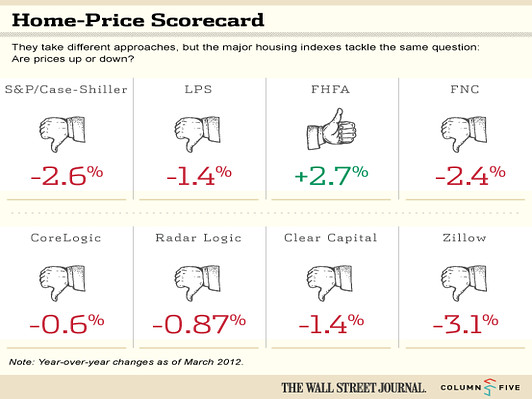Matthew Strozier over at WSJ with Column Five (a large producer of infographics) presented an interesting side by side of 8 national housing indices.
All but one index shows a year over year decline in housing. Trulia’s new Price Monitor by Jed Kolko would be a great addition once the year-over-year history is established. It was also interesting that NAR’s Existing Home Sales was omitted (I’m not advocating).
Beyond the obvious price decline, my takeaways were:
1. US indices are general in sync on the year-over-year. Our confusion in the monthly barrage of housing metric releases is that most push the month-over month.
2. With the proliferation of these indices, data subscriptions must be getting cheaper. There are a few more out there as well.
3. Of the indices presented, their data collection and methodologies vary significantly (where disclosed) yet their results were consistent perhaps suggesting the 7 for 8 result is coincidence as opposed to an aggregated trend.
4. Sales prices are not something we should be obsessed with as an indicator of market health (think Las Vegas, mid decade). I’d much prefer seeing more attention paid to sales trends since they are a pre-cursor to price trends if you are trying to reasonably answer the question: Has the US housing market hit bottom?
It is interesting and my rough understanding that most of these indices were created and run by economists, scientists or data wonks, many for Wall Street purposes with virtually no real estate types. That’s obviously fine until you consider what is said in barrage of monthly press releases for some, citing things that are not empirically measured in their respective reports, i.e. weather, inventory, etc. that create further confusion.
I’d love to see a side by side comparison of the lag time from the point of “meeting of the minds” between buyer and seller for each index. The significant lag time reflected in this index genre is a practical one due to the massive scale of information, but I think it would give consumers (who were generally not the intended users of any of these indices at the time they were created) a better sense of reliability for each.
National housing indices provide useful tools for setting government economic policy but the consumer’s obsession with the idea of a national housing market and it’s relevance to their local markets is, well, crazy.
One Comment
Comments are closed.



[…] The Crazy 8: Comparing Results of National Home Price Indices ~via Wall St. Journal […]